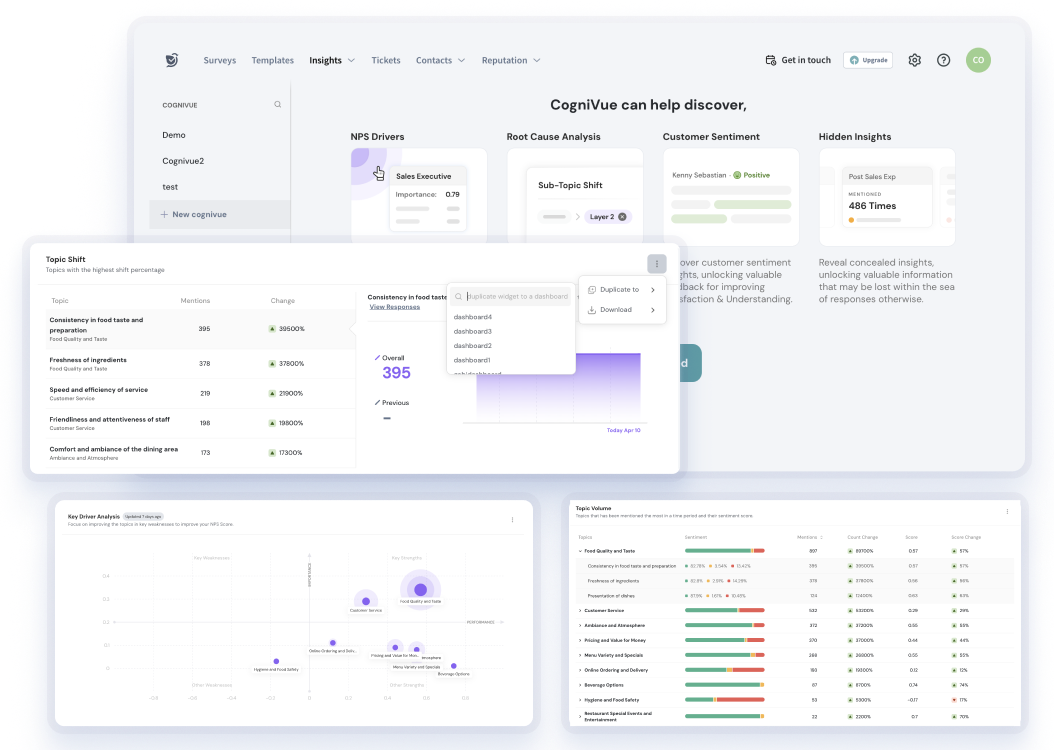Survey & Feedback
Open-Ended Survey Questions: Definition, Examples & Best Practices
Article written by Kate Williams
Product Marketing Manager at SurveySparrow
13 min read
19 September 2025

Open-ended questions are powerful tools that spark detailed, thoughtful responses—unlike yes/no questions. They're essential in surveys, interviews, and customer feedback because they uncover deeper insights into user motivations, experiences, and expectations.
Key Benefits
- Encourage honest, elaborative answers
- Help identify pain points and emotional drivers
- Improve decision-making with qualitative insights
Best Practices
- Start with “What,” “How,” or “Why”
- Avoid leading or biased phrasing
- Use them alongside closed-ended questions for balance
Examples include
- "What do you like most about our service?"
- "How can we improve your experience?"
Are you tired of getting one-word answers? We’ve all been there. The awkward silences that follow? They are also common in surveys! Crafting open ended questions that spark a conversation is a skill that’s worth learning – and one that’s also helpful in real life.
While the power of open-ended questions is undeniable, crafting them effectively can feel daunting. That’s because they require more thought and effort than their closed-ended counterparts. In this article, we’ll guide you through everything you need to know about open-ended survey questions.
- What are open-ended questions?
- Open-ended questions examples
- How to ask open-ended questions
- How to create an open-ended questionnaire
- How to analyze open-ended questions
- When to use open-ended questions
- Pros and Cons of using open-ended questions
- Open-ended vs close-ended questions
What Are Open-Ended Questions?
Open questions, also referred to as unstructured questions, typically begin with “What?”, “How?”, “Where?”or “Why?”.
One can define them as prompts that allow respondents to answer in their own words, without predefined options.
They don’t provide predefined answer options, allowing respondents to freely express their thoughts. The feedback you get here will come under qualitative feedback. The feedback, while it can be a bit hard to analyze, can provide much deeper insights about customer emotions and perceptions. In most cases, survey respondents are presented with a text box to write their responses, enabling detailed feedback.
For example, “How do I get to Middle Earth?” or “What’s in your handbag?”
Examples of Open-Ended Survey Questions
The following are some examples of open-ended survey questions used across various niches. We have also added some bonus questions for you.
NOW – If you are finding is difficult to find the right questions to ask in a survey, SurveySparrow can help here. The AI survey feature of the tool allows you to create one from scratch in mere seconds.

The feature is available with the free forever plan from SurveySparrow. Meaning – you can try this out for free. Use the below form to sign and try out.

Open-ended Questions for Customer Service
In a customer satisfaction survey, open-ended questions can help you truly understand an experience from the customer’s perspective. With the right phrasing, you can tap into the sentiment behind each experience, whether that’s delight, confusion, or frustration.
Here are some foolproof questions for customer service teams:
- What did you like the most about our product/service?
- Would you use our product/service again?
- Is there anything else you’d like to share?
Open-ended Questions for Employees
In an employee feedback survey, open questions highlight the “human” aspect of Human Resources. They can provide qualitative data and rich narratives, allowing you to go beyond numbers and understand the emotional aspects of employee satisfaction. You can use anonymous survey questions to encourage honest feedback.
- What do you love/hate about working here?
- What motivates you to give your best at work?
- Can you describe the greatest challenge you’ve ever faced at work?
Open-ended Questions for Sales
Open questions help you dig deep into prospects’ needs and pain points, so you can offer tailored solutions that hit the mark. By aligning your offerings with their goals, you show how your product or service can really make a difference. These questions also give you a peek into their decision-making process and who’s calling the shots, making your sales pitch smoother and building trust along the way.
- Can you tell me more about your specific needs and challenges?
- What goals are you looking to achieve with this product or service?
- How does your decision-making process typically work when considering a purchase like this?
Open-ended Questions for Retail
Open-ended questions allow sales associates to understand customer preferences through an organic conversation, rather a script. In a retail survey, they can unveil motivations for visiting, whether it’s a specific need or browsing. By understanding customers’ intended use, staff can upsell complementary items and enhance the overall shopping experience.
- What brought you into our store today?
- How do you plan to use this product?
- Have you had trouble finding something specific lately?
Open-ended Questions for Interview
Be it interviewing a potential candidate to hire or a prospect, including open-ended questions can be helpful. This is to provide an opportunity for the interviewee to express their opinions or concerns, which were not covered in other questions.
Some questions you can ask here are –
- Tell me about yourself.
- Where do you see yourself in the next five years?
- Explain a challenging project you have been part of.
- How would you handle conflicts in the workplace?
- What do you think is the reason for such a change in the market? (during market research)
Open-ended Questions for Banking
In banking, these questions are often asked to understand the financial goals, needs, and concerns of their customers. Depending on the customer feedback, bankers can provide tailored and personalized advice and solutions. The following are some open-ended questions you can ask.
- Can you tell me your financial goal for the next five years?
- How do you currently manage your finances?
- How do you envision your retirement?
- What are your biggest financial concerns right now?
Bonus: 10 Great Open-ended Questions for Conversation
Looking for a good ice-breaker? Here you go!
- “So, what’s your story? Tell me a bit about yourself.”
- “Looking ahead, what goals do you have for the next 5 years?”
- “How do you personally define success in your life?”
- “Outside of work, what are your favorite ways to spend your time?”
- “Can you share something you’re particularly proud of or passionate about?”
- “Do you have a favorite movie that you love to talk about? What makes it special?”
- “If you could plan your ideal date, what would it look like?”
- “What motivates you in both your personal and professional life?”
- “How do you like to challenge and push yourself?”
- “What do you believe sets you apart and makes you a valuable addition to a team?”
Fun fact: According to the Nielsen Norman Group, a survey with many open-ended questions will usually have a lower completion rate than one with more closed questions. Why? The answer lies below.
How to Ask Open-Ended Questions
There are some tips to consider while asking open-ended questions. The thing is, it can’t used every now and then in the survey. Why? Because it could make your feedback dilute and complex. so, the keep the following in mind while asking them.
1. Define Your Goals
Before crafting questions, clearly define what you want to achieve with the survey. Knowing your goals will help you frame effective questions.
2. Craft Clear & Engaging Prompts
Avoid generic prompts like “How was your experience?” Instead, use specific language that encourages detailed responses. For example, “What did you like most about our product?” or “Can you describe a situation where our service exceeded your expectations?”
3. Use Open-Ended Question Starters
Use power words like “Why,” “How,” “Tell us about,” or “Describe a situation where…” These prompts encourage insightful answers.
4. Mind the Question Length
While you want to encourage detailed responses, long questions can also be intimidating! Keep your prompts concise and focused on a single aspect of the experience.
5. Avoid Leading Language
Phrase your questions neutrally to avoid swaying people towards a specific answer. For example, instead of “Did you find our staff helpful?” ask, “Can you tell us about your interaction with our staff?”
6. Offer Response Options (Optional)
In some cases, providing a few open-ended response options can be helpful. This can nudge respondents in the right direction without limiting their answers.
7. Test Your Questions
Before launching your survey, conduct a pilot test with a small group. This allows you to see if your questions generate the type of responses you need.
How to Create an Open-Ended Questionnaire
We will take SurveySparrow to help you understand how to create open-ended questions. Follow the given instructions and create your own questions.
Step 1: Sign Up or Sign In
If you are already a user, simple sign in or log in. For new users, don’t worry, SurveySparrow offers a free forever plan you can make use of. As a bonus, you will also get access to all premium features with the 14-day free trial. No cost…no fuss.
Use the form to sign in and follow the rest of the steps as we discuss.
14-day free trial • Cancel Anytime • No Credit Card Required • No Strings Attached
Step 2: Creating open-ended questions
Method 1: Using AI
SurveySparrow AI feature helps you create a survey from scratch. It’s just like ChatGPT, you add in the prompt and the tool will generate the survey for you. [There’s also a ChatGPT integration with SurveySparrow you can use if needed].

Method 2: Manually
If you are new, then click on the “New Survey” button on the top right corner and start blank. If you are already an existing user, go to your “My Surveys” and select one.
Upon selecting a survey, you will see a set of survey questions you can choose from. From that, choose “Text”.
You can make the questions compulsory to attend, single or multiple lines, and even track for sentiment. You can also enable voice transcription and response translation.
Et Voila! That’s it. 
Now, the obvious question would be how you can analyze them.
How to Analyze Feedback from Open-Ended Questions
Open-ended questions provide you with qualitative feedback. So, analyzing it could be a bit tricky. But not with SurveySparrow with your side.

The tool provides you with an AI-powered advanced text analytics feature – CogniVue. It can easily analyze a vast number of unstructured data (qualitative feedback) and provide you with the following.
- Accurate customer sentiments
- Key drivers of your business
- The most discussed topic in the feedback
- The most used keyword by the customers
Interested in learning more about the feature? Connect with our team or use the below form to see it for yourself.

Explore Deeper Customer Insights with SurveySparrow
A personalized walkthrough by our experts. No strings attached!
The most important benefit of open-ended questions is that they allow you to find more than you anticipate.
– Susan Farrell, “Open-Ended vs Close Ended Questions in User Research”
When Should I Use Open Questions In My Survey?
The right time to ask open-ended questions depends on the type of survey you are running. Considering that in mind, we have created the following table. please have a look at them.
| Exploratory Research | Use open questions to gather initial thoughts and ideas. |
| Complex or Unpredictable Topics | Allow respondents to express themselves freely. |
| Qualitative Data Gathering | Collect opinions, personal stories, emotions, and perspectives. |
| Understanding Customer Feedback | Let customers articulate their concerns, suggestions, or praise in their own words. |
| Diverse Perspectives | Gather diverse viewpoints and encourage creativity. |
| Follow-up or Clarification | Delve deeper into specific survey responses or clarify ambiguous answers. |
| Testing Hypotheses | Support or challenge your assumptions with qualitative data. |
| Brainstorming and Idea Generation | Invite respondents to share their thoughts, ideas, or solutions. |
| Sensitive Topics | Allow respondents to express their feelings with empathy and without constraints. |
| In-Depth Interviews | Kickstart discussions and allow interviewees to provide detailed responses. |
8 Pros and Cons of Using Open-Ended Survey Questions
Like everything else, using open-ended survey questions comes with its pros and cons. The following are some of the pros and cons you should know about.
| PROS | CONS |
| Encourages detailed and thoughtful answers, providing deeper insights. | May attract overly detailed answers, which can be time-consuming to read. |
| Often reveals unexpected or unanticipated information. | Challenging to categorize compared to closed-ended responses. |
| Enable unique perspectives and ideas to emerge. | May lead to vague answers, making it challenging to extract meaningful insights. |
| Qualitative and descriptive, therefore providing richer data. | May vary widely, making it difficult to compare and draw conclusions. |
| Provides a deeper understanding of viewpoints, needs, or preferences. | May require more effort, leading to possible respondent fatigue or incomplete responses. |
| Enhances decision-making with nuanced information. | Analysis can be time-consuming without the right survey software. |
| Provide rich qualitative data that can uncover new perspectives, trends, and themes. | Ensuring consistency in open-ended responses across surveys can be tough. |
| Respondents often feel more engaged and valued when given the opportunity to share their opinions openly. | Respondents may feel overwhelmed or hesitant to provide lengthy responses, leading to incomplete or superficial answers. |
Open-Ended Vs. Close-Ended Survey Questions
You might have some questions regarding the difference between open-ended and close-ended questions, and we are here to answer them. The following table will help you a clear idea on what is what and which is which. Have a look at it.
| Open-ended Questions | Close-ended Questions |
| Respondents provide their own answers in their own words, typically using a text box or blank space. | Respondents choose from predefined answer options such as multiple-choice, rating scales or yes/no answers. |
| Require more thought and effort to answer, leading to lower form fills. | Require less effort to answer, leading to higher completion rates. |
| Allow for detailed and nuanced responses. | Offer limited response options. |
| Require more effort and time to analyze responses due to the variability in answers. | Quicker analysis as responses can be directly converted into tables or graphs. |
| Ideal for exploratory research, gathering in-depth insights, and understanding complex issues. | Well-suited for quantitative research, measuring responses in a standardized, comparable manner. |
The same question can be phrased differently depending on the format you choose. For instance:
Open-ended: What would you do if you were President for a day?
Close-ended: You are President for a day. Would you focus on:
a) Implementing new policies
b) Improving international relations
c) Addressing domestic issues
d) Other (please specify)
Need more samples you can use for your own survey? Try our Random Question Generator and get dozens of free questions!
Wrapping Up
Open-ended questions are like treasure chests in surveys. They uncover rich, qualitative insights that closed-ended ones might miss. However, remember to balance them with closed-ended questions for a well-rounded survey.
Be mindful, such questions can be time-consuming for both you and your respondents! So, use them strategically to keep your surveys or interviews engaging and insightful.

Create engaging surveys that people actually complete. Try SurveySparrow now!
Kate Williams
Excels in empowering visionary companies through storytelling and strategic go-to-market planning. With extensive experience in product marketing and customer experience management, she is an accomplished author, podcast host, and mentor, sharing her expertise across diverse platforms and audiences.
Frequently Asked Questions (FAQs)
Open-ended questions allow respondents to answer in their own words, providing detailed insights. Close-ended questions offer predefined options, making responses easier to quantify.
Use open-ended questions when you want to gather detailed feedback, explore new ideas, or understand the reasons behind certain behaviors.
Categorize responses into themes, look for common patterns, and use text analysis tools to process large datasets efficiently.
Related Articles

Survey & Feedback
Top 60+ Stress Survey Questions You Need to Ask in 2025
12 MINUTES
15 May 2022

Survey & Feedback
Customer Research 101: Definition, Types, and Methods
10 MINUTES
8 June 2021

Survey & Feedback
Having awful meetings on an otherwise nice day? Let’s change it
3 MINUTES
17 July 2020

Survey & Feedback
The One Where We Introduce Conversational Surveys
4 MINUTES
7 June 2018
